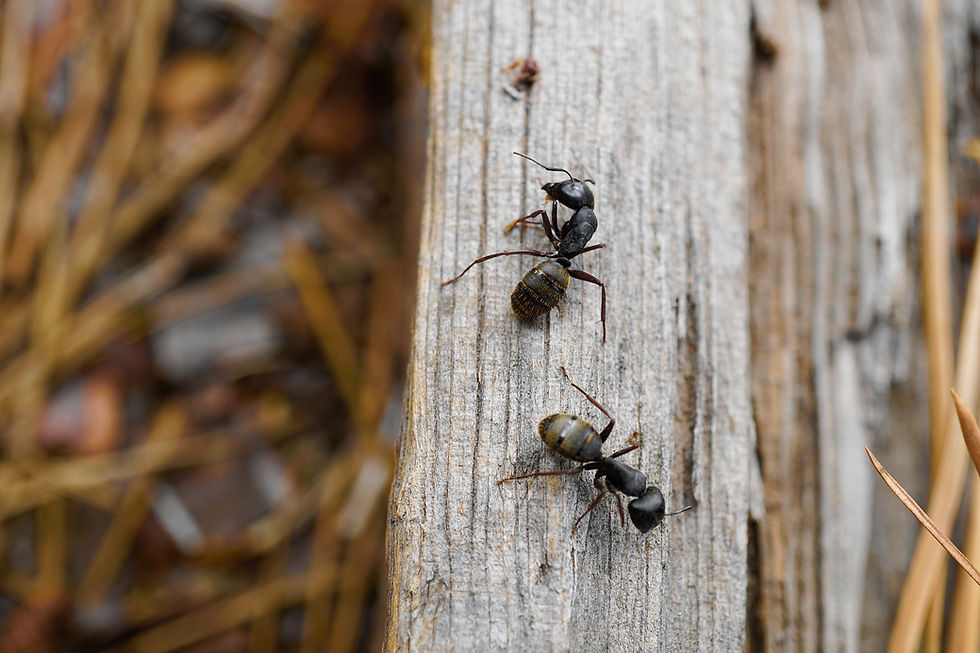Carpenter Ants: The Wood-Destroying Invaders You Can’t Ignore
- VecPest

- Dec 31, 2024
- 4 min read

You notice a trail of large black ants marching through your home, and at first, you think, “Just regular ants, right?” Think again. Carpenter ants are not your average ants—they’re silent invaders capable of causing significant damage to your home’s structure. While they don’t eat wood like termites, their ability to tunnel through it can still leave a trail of destruction.
In this blog, we’ll dive into the habits of carpenter ants, the risks they pose to your home, and why professional help is essential to protecting your property.
1. What Are Carpenter Ants?
Hook: Think you can spot a carpenter ant from a regular ant? Their size is only part of the story.
Carpenter ants are one of the largest ant species, ranging from 1/4 to 1/2 inch in length. They’re typically black but may also have reddish or brown tones. Unlike termites, carpenter ants don’t consume wood; instead, they excavate it to build their nests, weakening structures over time.
🕷 Fun Fact: Carpenter ants prefer moist or decayed wood, often making them a sign of underlying water damage in your home.
Practical Tip: Inspect areas prone to moisture, like basements and around windows, for signs of carpenter ant activity.
2. The Damage They Cause
Hook: A few ants here and there might seem harmless—but the real problem lies beneath the surface.
Carpenter ants burrow into wood to create smooth, tunnel-like galleries for their colonies. Over time, this weakens the structural integrity of wood components such as beams, floors, and walls. Left unchecked, they can cause damage that rivals termites in cost and severity.
📊 Stat Spotlight: According to the National Pest Management Association, carpenter ants are among the top culprits of structural pest damage in North America.
Practical Tip: Tap on wooden structures and listen for hollow sounds—this could indicate ant tunneling.
3. Signs of a Carpenter Ant Infestation
Hook: Spotting a carpenter ant trail isn’t the only clue they’re in your home.
Common signs of a carpenter ant infestation include:
Piles of sawdust-like material (called frass) near wooden areas
Rustling noises inside walls
Winged ants (swarmers) around windows or light fixtures
Wood that appears smooth or hollowed out
🔎 Pro Tip: If you find frass, it’s a strong indicator of carpenter ant activity—time to investigate further or call a pro.
Practical Tip: Check attics, crawl spaces, and areas with wood-to-soil contact, as these are common nesting spots.
4. Carpenter Ants vs. Termites: How to Tell the Difference
Hook: Not all wood-destroying pests are created equal—know your enemy.
Carpenter ants and termites are often confused, but there are key differences:
Appearance: Carpenter ants are larger and have a pinched waist, while termites have a straight body.
Behavior: Termites eat wood; carpenter ants only hollow it out.
Damage: Termite damage often appears rough and layered, while carpenter ant tunnels are smooth.
📢 Quote: “Identifying the pest is critical to choosing the right treatment,” says Dr. Michael Potter, an entomologist specializing in pest management.
Practical Tip: Use a flashlight to inspect dark corners and look for winged ants or termites during their swarming season.
5. DIY Carpenter Ant Control: Why It Often Falls Short
Hook: Spraying a few ants won’t solve the problem if the colony is still thriving.
DIY treatments like ant bait or insecticides might kill visible ants but rarely eliminate the entire colony. Carpenter ants often nest in hidden areas, such as wall voids or attic spaces, making them difficult to eradicate without professional tools and expertise.
🕵️ Fun Fact: A carpenter ant colony can have satellite nests spread across your home, complicating DIY control efforts.
Practical Tip: Use baits labeled specifically for carpenter ants, but call a professional if activity persists.
6. Professional Pest Control: The Smart Choice
Hook: When it comes to carpenter ants, professional expertise isn’t a luxury—it’s a necessity.
Pest control experts use advanced detection methods, such as moisture meters and thermal imaging, to locate nests and assess damage. They also apply targeted treatments, such as baiting systems or non-repellent insecticides, that effectively eliminate the colony.
📊 Stat Spotlight: Homes treated by professional pest control services are significantly less likely to experience reinfestations.
Practical Tip: Choose a pest control company that offers warranties for their work to ensure peace of mind.
7. Preventing Carpenter Ant Infestations
Hook: Stopping carpenter ants before they start is easier—and cheaper—than dealing with an infestation.
To prevent carpenter ants, focus on reducing moisture and eliminating wood-to-soil contact:
Fix Leaks: Repair leaky pipes and roofs promptly.
Seal Cracks: Close gaps around windows, doors, and foundations.
Remove Decayed Wood: Replace rotting wood and store firewood away from your home.
🌿 Pro Tip: Trim back tree branches and shrubs that touch your home, as they can act as bridges for carpenter ants.
Practical Tip: Schedule annual pest inspections to catch potential problems early.
Wrapping Up: Protecting Your Home from Carpenter Ants
Carpenter ants are more than just a nuisance—they’re a threat to your home’s structure and your wallet. Early detection, proper identification, and professional treatment are the keys to protecting your property from these wood-destroying pests.
Don’t let carpenter ants turn your home into their next big project. Stay vigilant, take preventative measures, and when in doubt, call in the experts. Your home—and peace of mind—are worth it!





Comments